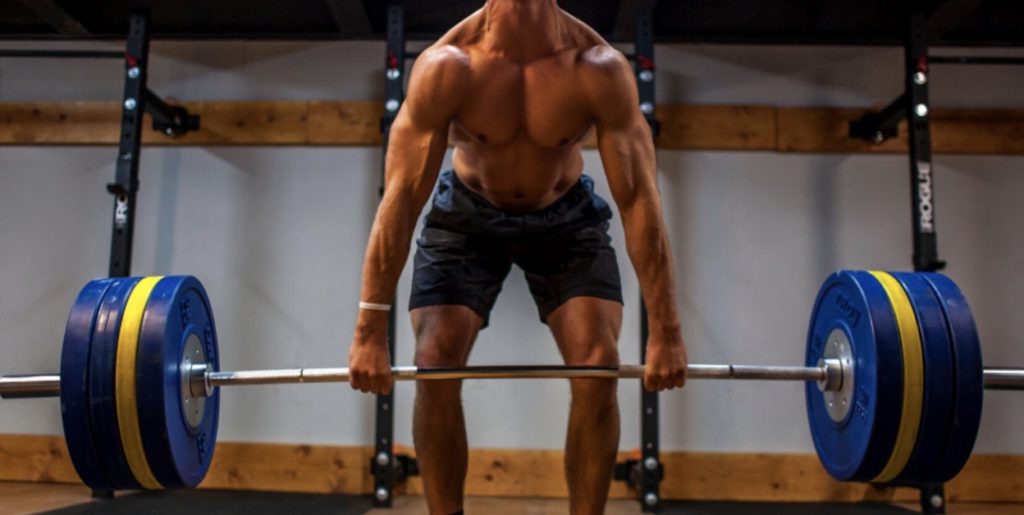Partial Rep Training For Full-Powered Results!
Partial Rep Training For Full-Powered Results!
partial reps are reps performed with any exercise limited to a certain range of motion. As opposed to completing a full range of motion exercise, partial reps are stopped and limited to a certain range of motion that can technically be defined by any parameters. Partial reps can be 3/4 of a movement, half of the movement, and even less.
In reality, partial reps are all defined as reps that are limited to a partial range of motion, but that partial range of motion can vary greatly based on the movement and the intent in which it is being performed. This opens up the possibility for multiple definitions in regards to partial reps.
Some partial rep exercises are used more frequently training and are more popular than others. For example, rack pulls, quarter squats, and board benches are all technically forms of partial rep exercises, and are used for multiple training adaptations.
The Science Behind Partial Reps
Full Vs. Partial Range of Motion and Muscle Damage
There has been limited research performed on partial reps and their best uses and benefits. Typically, studies using partial reps are doing so in order to compare them to full range of motion exercises.
In regards to muscle growth, we know (from what research has suggested) that muscle has a better potential to grow when it’s put through a full range of motion.This allows muscle to fully stretch eccentrically and contract concentrically, which can promote optimal growth. One study from 2017 published in the Journal of Strength and Conditioning Research compared partial and full range of motion reps and their ability to induce muscle damage (1).

In this study, researchers had participants perform full and partial unilateral preacher bicep curls for four sets with 10-reps with a weight of 80% of a subject’s 1-RM.Researchers analyzed muscle damage outcomes immediately after exercise, then 24, 48, and 72 hours respectively. To assess muscle damage, authors analyzed things like peak torque, muscle soreness with palpation, arm circumference, and range of motion.
While the weight was heavier in the partial range of motion group, the full range of motion participants had greater levels of muscle soreness and decreased range of motion following 72-hours of exercise. Authors suggested that full range of motion during elbow flexion exercises produced greater levels of muscle damage, which could suggest a better rate of hypertrophy and growth.
Partial Range of Motion Reps for Strength and Hypertrophy
Another interesting piece of research that compared full and partial range of motion reps comes from a study published in 2014 in the Journal of Strength and Conditioning Research (2). This study followed two groups of subjects that performed an 8-week resistance training program with either full (longer) ranges of motion or partial (shorter) ranges of motion, then followed a 4-week period of detraining. There was also a control group that was monitored.
Authors were curious about how different ranges of motion impacted muscle size, architecture, subcutaneous fat, and strength at 0, 8, 10, and 12-weeks following the respective resistance training programs. Following the 8-weeks of resistance training, both groups experienced gains in all measured parameters, but the full range of motion group experienced greater levels of strength, anatomical cross-sectional areas, fascicle length, and experienced more subcutaneous fat loss.
After the detraining period, the authors noted that partial range of motion group experienced more rapid losses in the gains they had recorded compared to the full range of motion group. Authors suggested that full ranges of motion should be utilized when strength and size are one’s main training concerns.

On the topic of muscular hypertrophy, a review published in 2018 in the Journal of Strength and Conditioning Research analyzed previous research that has been performed on full and partial reps and this particular training adaptation (3). Authors were interested in the potential mechanisms behind the different ranges of motion that could suggest and support optimal hypertrophy improvements in various muscle groups.
In the review, authors point out that research on this topic is scarce, and three mechanisms to consider when performing partial and full range of motion reps for hypertrophy are time under tension, muscle activation, and nonuniform hypertrophy.
They suggest that the varied force-lengths and strength-curves in different compound movements warrant further investigation with the efficacy of partial rep training and hypertrophy benefit. In layman’s terms, changes in joint angle and muscle recruitment could vary between compound exercises, and partial reps could potentially recruit more muscle than others for the purpose of increasing hypertrophy during various movements.
The final study we will look at comes from 2004 and was published in the Journal of Strength and Conditioning Research (4). This research compared the difference between full and partial range of motion reps on the bench press and their ability to increase strength. Researchers split subjects into three training groups which included full range of motion reps, partial range of motion reps, and a combination of both.
Participants followed a resistance training program for 10-weeks and performed their bench protocol twice per week. The groups performed 3 sets with 15 reps on the bench press and full range of motion group started with 65% of their 1-RM and the partial range of motion group used 100% of their 1-RM. The group that used a combination of both performed 2:1 partial:full range of motion sets for weeks 1-5, then flipped that ratio for weeks 6-10.
After the 10-weeks, authors noted that all groups experienced nearly identical strength improvements. Researchers suggested that partial range of motion reps could be used as supplemental exercises for development of strength when added to a balanced training program.
Practical Research Takeaways
Research is still pretty thin on the use of partial reps for strength, hypertrophy, and power, however, there were a few takeaways we can gather from the research observed above.
- Full range of motion reps tend to produce more muscle damage, strength, and muscle thickness compared to partial reps.
- Partial reps can be loaded heavier and performed longer, thus creating a need to further explore their use when hypertrophy is the goal.
- Partial reps may have use in a program when combined with full reps when strength is the goal.
- It’s also important to note that the training demographics were not all experienced strength athletes, which could potentially change the outcome of the studies.
Another thing to note about partial reps and their efficacy in training is the context in which they are being used. Athletes and coaches have used partial reps for years to develop certain performance attributes.
So this topic, while light in research, has been used in the gym for years with various levels of success. It’s most important to understand one’s body, training goals, and why something is being used to obtain the maximal benefit.

When Can Partial Reps Be Useful
Working Through Sticking Points and Plateaus
One way partial reps can be useful in strength training is when working through sticking points and plateaus. In strength sports specifically, partial reps are often developed solely for the focus of fixing a sticking point during a certain lift, as they typically involve supramaximally loading the body during a particular range of motion.
On top of working through sticking points, partial reps can be useful for working through a plateau. By decreasing the range of motion for a training block, athletes can recover, focus on their efficiency with the particular range of motion being trained, and load the body with often heavier weight compared to full range of motion reps.
Increasing Time Under Tension
Time under tension is often suggested to be one of the main training mechanisms for producing hypertrophy. Partial reps allow an athlete to perform higher volumes of reps for longer durations due to their ability to prolong one’s levels of fatigue.
Additionally, since an athlete is working with a smaller range of motion during partial reps, then movements can often be slowed down by increasing tempo and they can be useful for focusing on the mind-muscle connection.
Working Around An Injury
An often not talked about benefit of partial reps is working around an injury. Injuries can drastically decrease one’s ability to perform full ranges of motion during exercises. Partial reps, at times, can be useful for continual progress when working around a limitation caused by injury at any particular joint. They can also be useful to limit the amount detraining the body can experience when injuries are present.
Which Athletes Should Use Partial Reps
The use of partial reps will vary greatly between strength athletes, recreational lifters, and the general population. It’s also important to remember that all levels of fitness can use partial reps, but their use will vary greatly. Beginners will typically use partial reps to improve form at certain portions of lifts, while experienced athletes will use them for very specific training goals.
That being said, there’s not a true one-size-fits-all formula for employing this training strategy, however, we can use wha we know about partial reps to our best knowledge with training goals and adaptations in mind. Below are some recommendations different populations can use partial reps.
Powerlifters, Strongman Athletes, and Weightlifters.
- Why Use Them: Plateaus, sticking points, and working around injuries.
- When to Use Them: Off-season training blocks and meet prep when the goal is a particular portion of the lift or when one is trying to limit their overall workload.
- How to Use Them: For supramaximally loading or increasing time under tension for sticking points on the big three.
General Population
- Why Use Them: Improve movement efficiency and working around injury.
- When to Use Them: Trouble understanding certain portions of lifts and inability to perform full ranges of motion.
- How to Use Them: As a supplementary movement to engrain proper movement mechanics.
Wrapping Up
Partial reps have been used in strength training for a very long time and continue to have use when particular training adaptations are the goals. Are partial reps better than full reps? The research suggests not so much for strength and size, however, context can change per individual and sport which will improve a partial rep’s all-around efficacy on training.
References
1. Baroni BM, e. (2019). Full Range of Motion Induces Greater Muscle Damage Than Partial Range of Motion in Elbow Flexion Exercise With Free Weights. – PubMed – NCBI . Ncbi.nlm.nih.gov. Retrieved 12 April 2019.
2. McMahon GE, e. (2019). Impact of range of motion during ecologically valid resistance training protocols on muscle size, subcutaneous fat, and strength. – PubMed – NCBI . Ncbi.nlm.nih.gov. Retrieved 12 April 2019.
3. WilloughDS, N. (2019). Partial Compared with Full Range of Motion Resistance Training for Muscle Hypertrophy: A Brief Review and an Identification of Potential Mechanisms. – PubMed – NCBI . Ncbi.nlm.nih.gov. Retrieved 12 April 2019.
4. Massey CD, e. (2019). An analysis of full range of motion vs. partial range of motion training in the development of strength in untrained men. – PubMed – NCBI . Ncbi.nlm.nih.gov. Retrieved 12 April 2019.















0 Response to "Partial Rep Training For Full-Powered Results!"
Post a Comment
Note: Only a member of this blog may post a comment.